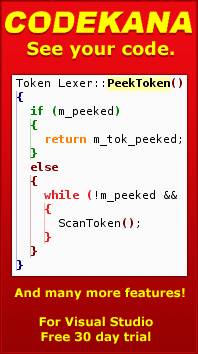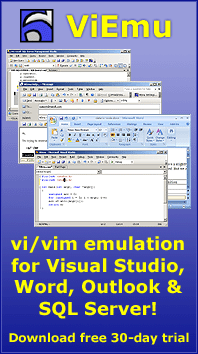Enlightment
See, I had an enlightening experience yesterday. I now know exactly what the best roadmap to follow with NGEDIT is.
I’ve just finished ViEmu 1.3 with the powerful regular expressions and ex command line support. I haven’t been able to release it yet, as Microsoft has changed the way you get the PLK (“package load key”) which you have to include in every new version of your product. It was automated beforehand, so you filled the online form and received the PLK in an e-mail 30 seconds afterwards. But with the release of Visual Studio 2005, they now want to actually approve your product before issuing the key. This means I’m stuck with the code and the whole web info revamp at home. Ah well, I’m a bit angry with that, but then you’re at their mercy – and the important lesson is: I could have filled out forms for ViEmu 1.3, 1.4, 1.5, 1.6, … and even 2.0 last month, and I would have the keys nicely stored in my hard disk. Something to watch out for in the future: anything you use which is a web service is not under your control, remove that dependency if you can.
Anyway, going back to the point, now that ViEmu 1.3 is ready, I am putting ViEmu development to a secondary position, and getting focus back on NGEDIT. ViEmu is now at a more than acceptable level, and although I’ll keep improving it, I better focus on NGEDIT which is the product with most potential.
I’ve already talked in the past about how to tackle the development of NGEDIT. I give a lot of thought to how I invest my time – not in order not to make mistakes, I make many of them and it’s not really a problem. But I like to think and rethink what my goals are, what the best way to reach them is, what the tasks are, and how (and in what order) it makes most sense to work. Once I developed ViEmu, I had quite clear that I had to keep putting a lot of effort until the product reached a “serious” level. Slowing down beforehand wouldn’t make any sense: even if the vi-lovers audience is a small one, the only way to actually discover its size is to get a decent product out there. A so-so product would leave me thinking, if sales are not big, that the problem was the product’s quality.
And now that I’m focusing on NGEDIT, deciding exactly how to work on it is no easy feat. I’ve already talked about this in the past, but I had already decided that I would focus on an NGEDIT 1.0 which had some of the compelling innovative parts – no sense to release YATE (“yet another text editor”) and hope it will bring a decently sized audience. I actually started designing and coding some of the most interesting parts of NGEDIT, even if many of the core parts are yet incomplete.
But now that I’ve already started opening the NGEDIT workspace from Visual Studio, the amount of things that I can do (and that I have to do in some moment) is mind boggling. Just to list a very few:
- Make the menus configurable… they actually are, but the UI is not there. Of course, this is one-in-one-hundred little things that need to be done.
- Integrate it well with windows: registry entries, shell extension, etc…
- Let the user configure the editor window colors – now all the UI elements can be configured, with the exception of the actual text-editing window itself (funny, as that’s the most important part).
- Finally finish off implementing that DBCS support for japanese/etc… – it’s designed in, but it’s not implemented. Either that, or properly remove support for it for 1.0.
- Now that ViEmu is so complete… port back the emulation functionality to NGEDIT. The vi/vim emulation in NGEDIT is written in my scripting language, it’s already 4 months old, and really basic compared to what ViEmu does. While I’m at it, properly structure it so that the vi/vim emulation core is shared code between ViEmu and NGEDIT – once again template based, text-encoding independent, and supporting integration with both mammooth and invasive environments, such as VS (where the vi/vim emu core is just a “slave”), and also with a friendlier environment like NGEDIT, that is already thought out to provide custom editor emulation.
- Clean up many things in the code base – you know, after you’ve been months away from the code, you come back and see many things which are plain malformed. Sure, you also kind of know about them when you are actually coding, but you have to get the job done and you do take shortcuts. I believe in shortcuts, it’s the way to actually advance, but then you want to properly pave those shortcuts into proper roads.
- Really study all that maddeningly beautiful mac software, understand what the heck makes it so incredibly and undeniably beautiful, and try to bring some of that beauty to NGEDIT.
- Actually work in the most innovative aspects of NGEDIT – the parts with which I hope to create an outstanding product.
- etc…
You can see… this is just a sample. Not to mention the many things that I have in my todo list, in my various “NGEDIT 1.0 FEATURE LIST” lists, in my handwritten sketches, etc…
It can be quite overwhelming… where do I start? And worse than that, you need motivation to actually be productive. See, one thing is that I’m determined to work on NGEDIT. Another thing is that I need to give myself something concrete to focus on, with which I feel comfortable strategy-wise, so that I will put all my energy on it.
Not having a single idea on how to tackle a problem is blocking. Having too many ideas or tasks can be as blocking.
This is a common problem when you are developing – sometimes, the only way out of such blocking crossroads is to start from the top of the list, even if it is alphabetically sorted, and work on items one by one. I have found that this works best for me when I am about to finish a release of a product or a development cycle. When, after digging for weeks or months, you see the light at the end of the tunnel, but there is still a lot of digging to be done, a similar phenomenon happens. And what I usually do is visualize the image of the finished product on my mind, and then just work on the items in sequential order (not sequential by priority, sequential by whatever random order they ended up listed on the todo list).
But I couldn’t see myself doing this for NGEDIT now – it’s still to far from any end of any tunnel.
I decided to just start browsing around the source code, thinking about code-architecture issues (I have never stopped thinking about many NGEDIT product details even while I was working 100% on ViEmu), and just spending my time with NGEDIT until the mud would clear up.
And it’s happenned – I’ve seen exactly the right way to approach it.
What is it? I just need to start actually using NGEDIT. I’m so fortunate that I use a text editor daily during many hours, for many tasks, and I can just use that time on NGEDIT – and just implement the stuff I need along the way! It’s clear, I just need to make it the best editor for me, and the rest will follow naturally. No need to prioritize features, no need to do heavy code spelunking, just start using it and implement the stuff as I go.
Which ones have been the first tasks to come out of this? Two quite obvious one – first, I needed to fix a bug in BOM-mark autodetection code, as I tried to use NGEDIT to edit some registry-export files, and I just noticed the bug while using it. And second, and the reason I was working on registry-exports, I need to implement associating file extensions to NGEDIT so that I can just double-click on files! And that requires that I implement command line parsing in NGEDIT (which, of course, was buried somewhere around #53 in the todo list!). Why? Because if I am to use NGEDIT for all my tasks, I just need to open files efficiently now.
It’s incredible how this path is already starting to work – I’m writing this blog post in NGEDIT, and the most important part is that I already feel confident. Confident that I’m on the right track for the earliest possible release date. And that lets me relax and focus on actual work.



November 7th, 2005 at 5:23 am
Yes, setting those priorities is a tough thing! You are lucky that you are working on a project which you can use yourselves daily and decide what to build next!
BTW, have you looked at the mac editor TextMate? The demos available at http://macromates.com/ are simply awesome. I have tried all the Windows editor out there but not a single one of them is capable of doing everything which Textmate offers. I like how Snippets have multiple placeholders and also column typing. It will be really great if NGEDIT would have some of these features.
JD
November 7th, 2005 at 4:40 pm
I am indeed lucky in that aspect, other areas do not allow such an approach.
A friend actually passed along a link to TextMate just yesterday. The comment on the beauty of Mac software came from that, and from the host of other Mac software I follow (Flying meat software by Gus Mueller, etc…). I always feel envy of Mac software, even just from seeing the icons of their apps!
Snippets may make their way into NGEDIT – probably not for 1.0, but quite possibly later on.
November 24th, 2005 at 8:02 pm
[…] I recently posted about how I had found out the best way to focus my development efforts on NGEDIT. To sum up: try to use it, and implement the features as their need is evident (I’m fortunate enough that I am 100% a future user of my own product). As the first point coming out from that, I found myself working into getting NGEDIT to open a file from the command line. That’s weeks ago, and I have only almost implemented it. How come? It should be simple enough to implement! (At least, given that opening the file through the file-open dialog was already functional). […]